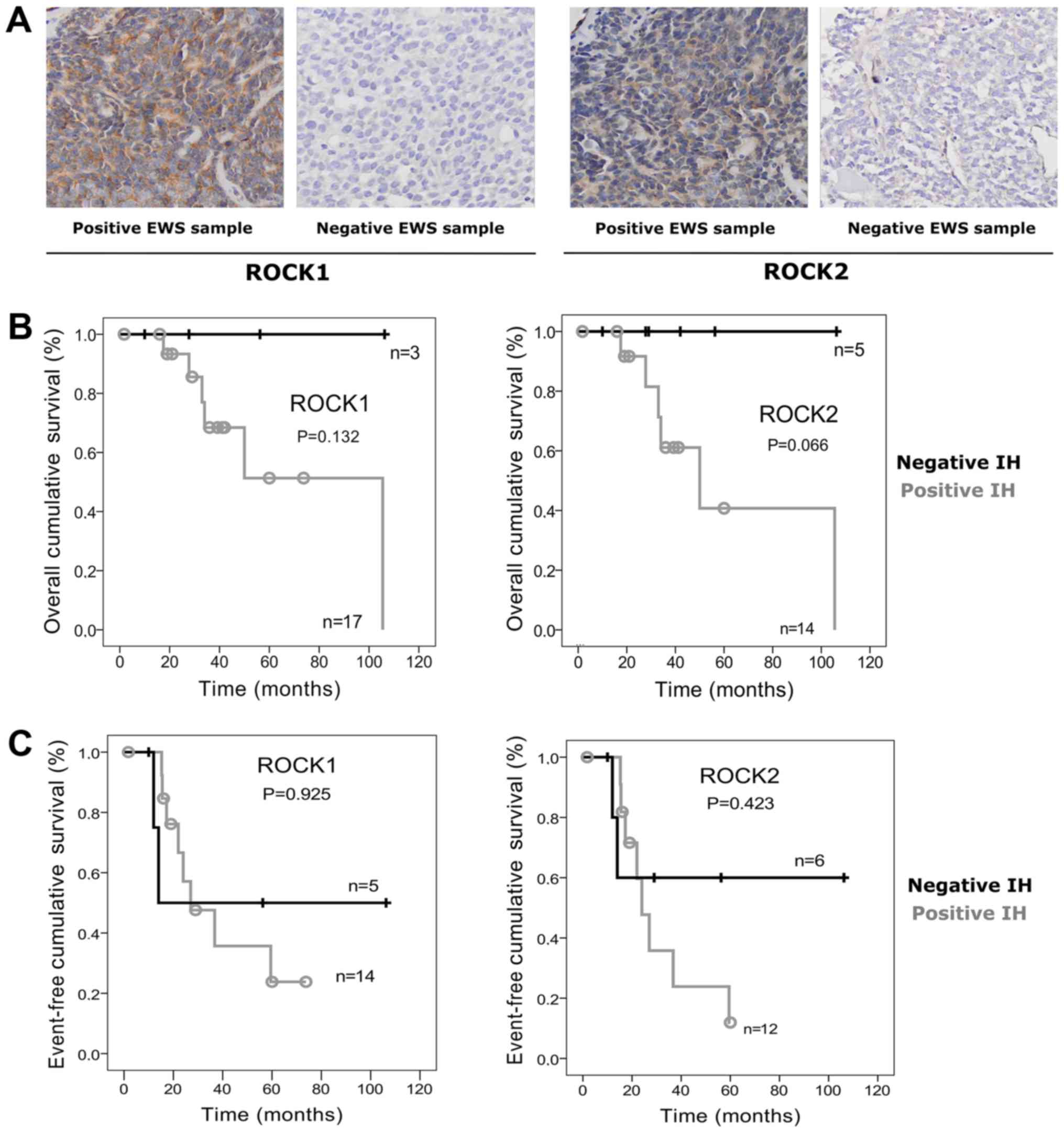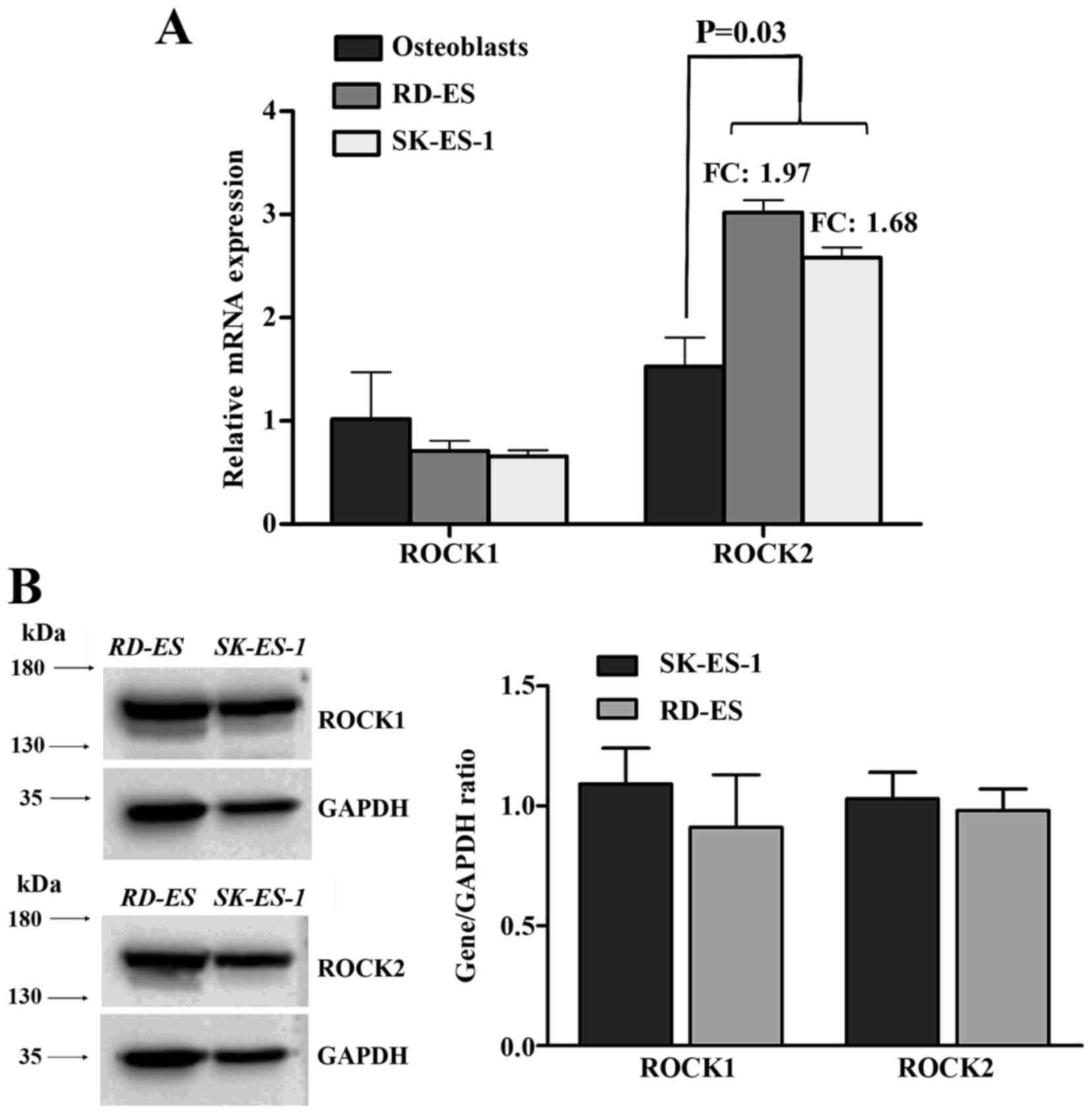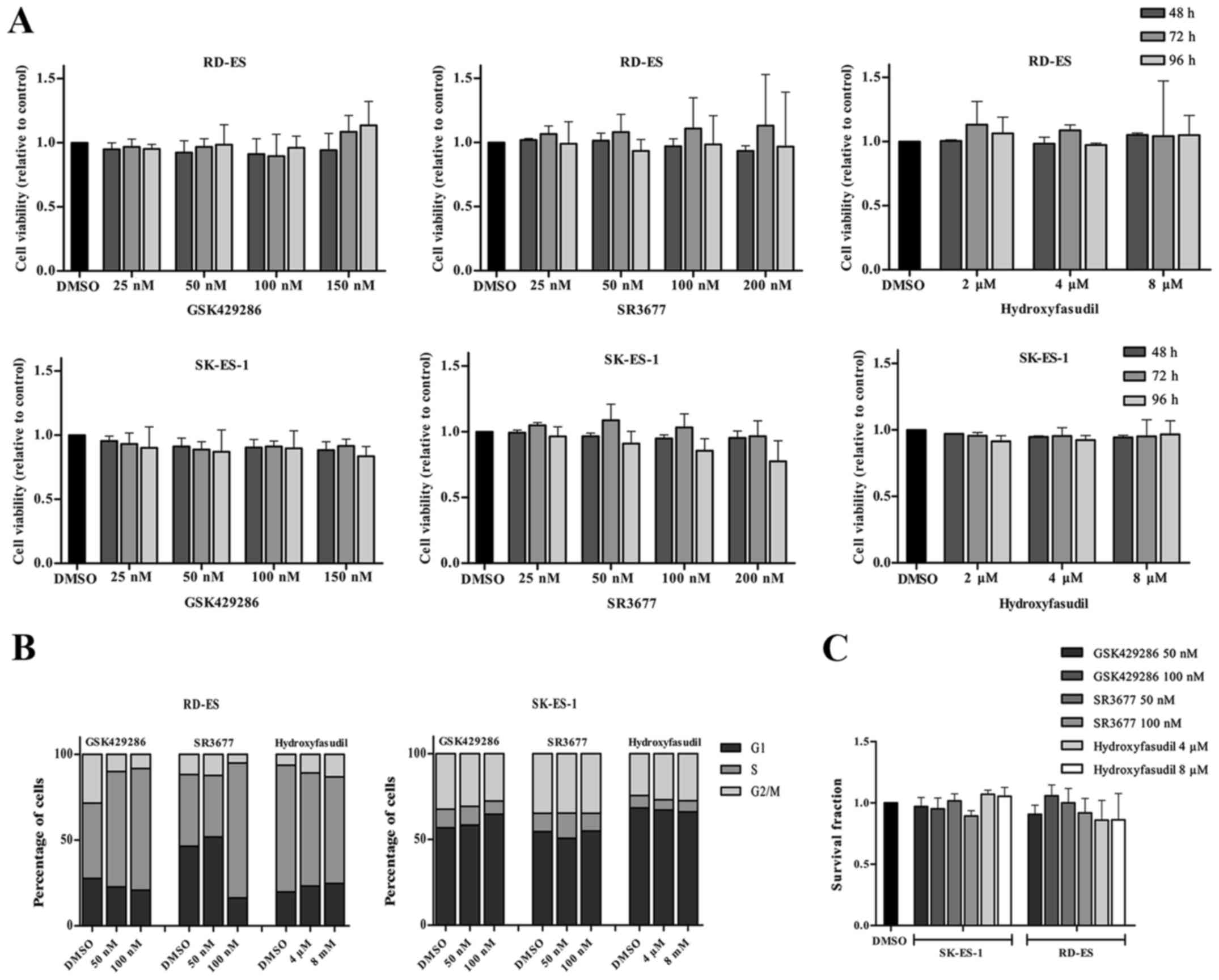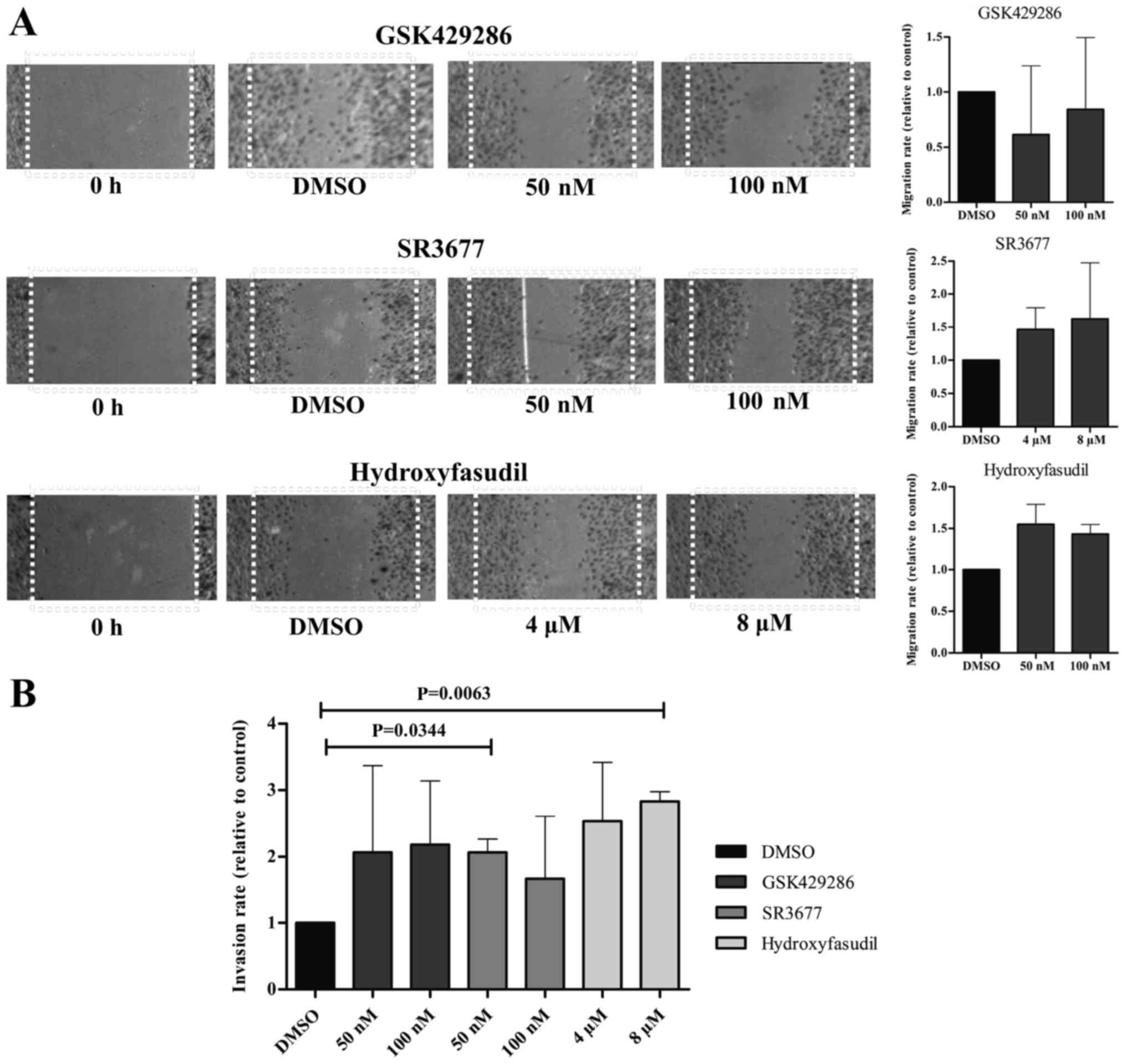|
1
|
West DC: Ewing sarcoma family of tumors.
Curr Opin Oncol. 12:323–329. 2017. View Article : Google Scholar
|
|
2
|
Ladenstein R, Pötschger U, Le Deley MC,
Whelan J, Paulussen M, Oberlin O, van den Berg H, Dirksen U, Hjorth
L, Michon J, et al: Primary disseminated multifocal Ewing sarcoma:
Results of the Euro-EWING 99 trial. J Clin Oncol. 28:3284–3291.
2010. View Article : Google Scholar : PubMed/NCBI
|
|
3
|
Bernstein M, Kovar H, Paulussen M, Randall
RL, Schuck A, Teot LA and Juergens H: Ewing's sarcoma family of
tumors: Current management. Oncologist. 11:503–519. 2006.
View Article : Google Scholar : PubMed/NCBI
|
|
4
|
Pinca RS, Manara MC, Chiadini V, Picci P,
Zucchini C and Scotlandi K: Targeting ROCK2 rather than ROCK1
inhibits Ewing sarcoma malignancy. Oncol Rep. 37:1387–1393. 2017.
View Article : Google Scholar : PubMed/NCBI
|
|
5
|
Hsu CY, Chang ZF and Lee HH:
Immunohistochemical evaluation of ROCK activation in invasive
breast cancer. BMC Cancer. 15:9432015. View Article : Google Scholar : PubMed/NCBI
|
|
6
|
Vigil D, Kim TY, Plachco A, Garton AJ,
Castaldo L, Pachter JA, Dong H, Chen X, Tokar B, Campbell SL and
Der CJ: ROCK1 and ROCK2 are required for non-small cell lung cancer
anchorage-independent growth and invasion. Cancer Res.
72:5338–5347. 2012. View Article : Google Scholar : PubMed/NCBI
|
|
7
|
Zhang J, He X, Ma Y, Liu Y, Shi H, Guo W
and Liu L: Overexpression of ROCK1 and ROCK2 inhibits human
laryngeal squamous cell carcinoma. Int J Clin Exp Pathol.
8:244–251. 2015.PubMed/NCBI
|
|
8
|
Zhang P, Lu Y, Liu XY and Zhou YH:
Knockdown of Rho-associated protein kinase 1 suppresses
proliferation and invasion of glioma cells. Tumour Biol.
36:421–428. 2015. View Article : Google Scholar : PubMed/NCBI
|
|
9
|
Kroiss A, Vincent S, Decaussin-Petrucci M,
Meugnier E, Viallet J, Ruffion A, Chalmel F, Samarut J and Allioli
N: Androgen-regulated microRNA-135a decreases prostate cancer cell
migration and invasion through downregulating ROCK1 and ROCK2.
Oncogene. 34:2846–2855. 2015. View Article : Google Scholar : PubMed/NCBI
|
|
10
|
Sun K, Duan X, Cai H, Liu X, Yang Y, Li M,
Zhang X and Wang J: Curcumin inhibits LPA-induced invasion by
attenuating RhoA/ROCK/MMPs pathway in MCF7 breast cancer cells.
Clin Exp Med. 16:37–47. 2016. View Article : Google Scholar : PubMed/NCBI
|
|
11
|
Livak KJ and Schmittgen TD: Analysis of
relative gene expression data using real-time quantitative PCR and
the 2(-Delta Delta C(T)) method. Methods. 25:402–408. 2001.
View Article : Google Scholar : PubMed/NCBI
|
|
12
|
Varghese F, Bukhari AB, Malhotra R and De
A: IHC Profiler: An open source plugin for the quantitative
evaluation and automated scoring of immunohistochemistry images of
human tissue samples. PLoS One. 9:e968012014. View Article : Google Scholar : PubMed/NCBI
|
|
13
|
Franken NA, Rodermond HM, Stap J, Haveman
J and van Bree C: Clonogenic assay of cells in vitro. Nat Protoc.
1:2315–2319. 2006. View Article : Google Scholar : PubMed/NCBI
|
|
14
|
Liang CC, Park AY and Guan JL: In vitro
scratch assay: A convenient and inexpensive method for analysis of
cell migration in vitro. Nat Protoc. 2:329–333. 2007. View Article : Google Scholar : PubMed/NCBI
|
|
15
|
Matsumura F: Regulation of myosin II
during cytokinesis in higher eukaryotes. Trends Cell Biol.
15:371–377. 2005. View Article : Google Scholar : PubMed/NCBI
|
|
16
|
Izawa I and Inagaki M: Regulatory
mechanisms and functions of intermediate filaments: A study using
site- and phosphorylation state-specific antibodies. Cancer Sci.
97:167–174. 2006. View Article : Google Scholar : PubMed/NCBI
|
|
17
|
Shi J, Surma M, Zhang L and Wei L:
Dissecting the roles of ROCK isoforms in stress-induced cell
detachment. Cell Cycle. 12:1492–1500. 2013. View Article : Google Scholar : PubMed/NCBI
|
|
18
|
Kamai T, Tsujii T, Arai K, Takagi K, Asami
H, Ito Y and Oshima H: Significant association of Rho/ROCK pathway
with invasion and metastasis of bladder cancer. Clin Cancer Res.
9:2632–2641. 2003.PubMed/NCBI
|
|
19
|
Lane J, Martin TA, Watkins G, Mansel RE
and Jiang WG: The expression and prognostic value of ROCK I and
ROCK II and their role in human breast cancer. Int J Oncol.
33:585–593. 2008.PubMed/NCBI
|
|
20
|
Liu X, Choy E, Hornicek FJ, Yang S, Yang
C, Harmon D, Mankin H and Duan Z: ROCK1 as a potential therapeutic
target in osteosarcoma. J Orthop Res. 29:1259–1266. 2011.
View Article : Google Scholar : PubMed/NCBI
|
|
21
|
Babeto E, Conceição AL, Valsechi MC,
Junior P Peitl, de Campos Zuccari DA, de Lima LG, Bonilha JL, de
Freitas Calmon M, Cordeiro JA and Rahal P: Differentially expressed
genes in giant cell tumor of bone. Virchows Arch. 458:467–476.
2011. View Article : Google Scholar : PubMed/NCBI
|
|
22
|
Wu YJ, Tang Y, Li ZF, Li Z, Zhao Y, Wu ZJ
and Su Q: Expression and significance of Rac1, Pak1 and Rock1 in
gastric carcinoma. Asia Pac J Clin Oncol. 10:e33–e39. 2014.
View Article : Google Scholar : PubMed/NCBI
|
|
23
|
Itoh K, Yoshioka K, Akedo H, Uehata M,
Ishizaki T and Narumiya S: An essential part for Rho-associated
kinase in the transcellular invasion of tumor cells. Nat Med.
5:221–225. 1999. View
Article : Google Scholar : PubMed/NCBI
|
|
24
|
Genda T, Sakamoto M, Ichida T, Asakura H,
Kojiro M, Narumiya S and Hirohashi S: Cell motility mediated by rho
and Rho-associated protein kinase plays a critical role in
intrahepatic metastasis of human hepatocellular carcinoma.
Hepatology. 30:1027–1036. 1999. View Article : Google Scholar : PubMed/NCBI
|
|
25
|
Takamura M, Sakamoto M, Genda T, Ichida T,
Asakura H and Hirohashi S: Inhibition of intrahepatic metastasis of
human hepatocellular carcinoma by Rho-associated protein kinase
inhibitor Y-27632. Hepatology. 33:577–581. 2001. View Article : Google Scholar : PubMed/NCBI
|
|
26
|
Nakajima M, Katayama K, Tamechika I,
Hayashi K, Amano Y, Uehata M, Goto N and Kondo T: WF-536 inhibits
metastatic invasion by enhancing the host cell barrier and
inhibiting tumour cell motility. Clin Exp Pharmacol Physiol.
30:457–463. 2003. View Article : Google Scholar : PubMed/NCBI
|
|
27
|
Patel RA, Forinash KD, Pireddu R, Sun Y,
Sun N, Martin MP, Schönbrunn E, Lawrence NJ and Sebti SM: RKI-1447
is a potent inhibitor of the Rho-associated ROCK kinases with
anti-invasive and antitumor activities in breast cancer. Cancer
Res. 72:5025–5034. 2012. View Article : Google Scholar : PubMed/NCBI
|
|
28
|
Abe H, Kamai T, Hayashi K, Anzai N,
Shirataki H, Mizuno T, Yamaguchi Y, Masuda A, Yuki H, Betsunoh H,
et al: The Rho-kinase inhibitor HA-1077 suppresses
proliferation/migration and induces apoptosis of urothelial cancer
cells. BMC Cancer. 14:4122014. View Article : Google Scholar : PubMed/NCBI
|
|
29
|
Ohnaka K, Shimoda S, Nawata H, Shimokawa
H, Kaibuchi K, Iwamoto Y and Takayanagi R: Pitavastatin enhanced
BMP-2 and osteocalcin expression by inhibition of Rho-associated
kinase in human osteoblasts. Biochem Biophys Res Commun.
287:337–342. 2001. View Article : Google Scholar : PubMed/NCBI
|
|
30
|
Shimokawa H: Rho-kinase as a novel
therapeutic target in treatment of cardiovascular diseases. J
Cardiovasc Pharmacol. 39:319–327. 2002. View Article : Google Scholar : PubMed/NCBI
|
|
31
|
Hinderling PH, Karara AH, Tao B, Pawula M,
Wilding I and Lu M: Systemic availability of the active metabolite
hydroxy-fasudil after administration of fasudil to different sites
of the human gastrointestinal tract. J Clin Pharmacol. 47:19–25.
2007. View Article : Google Scholar : PubMed/NCBI
|
|
32
|
Goodman KB, Cui H, Dowdell SE,
Gaitanopoulos DE, Ivy RL, Sehon CA, Stavenger RA, Wang GZ, Viet AQ,
Xu W, et al: Development of dihydropyridone indazole amides as
selective Rho-kinase inhibitors. J Med Chem. 50:6–9. 2007.
View Article : Google Scholar : PubMed/NCBI
|
|
33
|
Feng Y, Yin Y, Weiser A, Griffin E,
Cameron MD, Lin L, Ruiz C, Schürer SC, Inoue T, Rao PV, et al:
Discovery of substituted
4-(pyrazol-4-yl)-phenylbenzodioxane-2-carboxamides as potent and
highly selective Rho kinase (ROCK-II) inhibitors. J Med Chem.
51:6642–6645. 2008. View Article : Google Scholar : PubMed/NCBI
|
|
34
|
Wang HL, Hu SH, Chou AH, Wang SS, Weng YH
and Yeh TH: H1152 promotes the degradation of
polyglutamine-expanded ataxin-3 or ataxin-7 independently of its
ROCK-inhibiting effect and ameliorates mutant ataxin-3-induced
neurodegeneration in the SCA3 transgenic mouse. Neuropharmacology.
70:1–11. 2013. View Article : Google Scholar : PubMed/NCBI
|
|
35
|
Nichols RJ, Dzamko N, Hutti JE, Cantley
LC, Deak M, Moran J, Bamborough P, Reith AD and Alessi DR:
Substrate specificity and inhibitors of LRRK2, a protein kinase
mutated in Parkinson's disease. Biochem J. 424:47–60. 2009.
View Article : Google Scholar : PubMed/NCBI
|
|
36
|
Chapman S, McDermott DH, Shen K, Jang MK
and McBride AA: The effect of Rho kinase inhibition on long-term
keratinocyte proliferation is rapid and conditional. Stem Cell Res
Ther. 5:602014. View
Article : Google Scholar : PubMed/NCBI
|
|
37
|
Luo W, Xu C, Ayello J, et al: Protein
phosphatase 1 regulatory subunit 1A (PPP1R1A) promotes tumor growth
and metastasis via inhibition of protein phosphatase 1 in Ewing
sarcoma. AACR 107th Annual Meeting 2016 American Association for
Cancer Research. New Orleans, LA. 2016;
|
|
38
|
Bouin AP, Kyumurkov A, Régent-Kloeckner M,
Ribba AS, Faurobert E, Fournier HN, Bourrin-Reynard I, Manet-Dupé
S, Oddou C, Balland M, et al: ICAP-1 monoubiquitylation coordinates
matrix density and rigidity sensing for cell migration through
ROCK2-MRCKα balance. J Cell Sci. 130:626–636. 2017. View Article : Google Scholar : PubMed/NCBI
|
|
39
|
Hotfilder M, Sondermann P, Senss A, van
Valen F, Jürgens H and Vormoor J: PI3K/AKT is involved in mediating
survival signals that rescue Ewing tumour cells from fibroblast
growth factor 2-induced cell death. Br J Cancer. 92:705–710. 2005.
View Article : Google Scholar : PubMed/NCBI
|
|
40
|
Mertsch S and Thanos S: Opposing signaling
of ROCK1 and ROCK2 determines the switching of substrate
specificity and the mode os migration of glioblastoma cells. Mol
Neurobiol. 49:900–915. 2014. View Article : Google Scholar : PubMed/NCBI
|


















